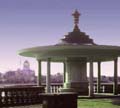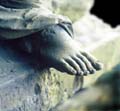
|
RESTORATION
"Tradition doesn’t mean to protect cinders but to preserve burning the flame."
The term "restoration" means securing, cleaning, strengthening, preservation, completion, retouching or copy of a monument. With the maintenance of buildings, monuments, works of art etc. one tries to stop and partly revoke the deterioration of cultural heritage. Deterioration occurs with time, through wartime destruction, weathering, wear and tear. Sometimes restoration is seen as falsification, in particular if it involves reconstruction. Therefore opinions are divided on the modern conservation of architectural heritage and the role restoration can play. Some prefer an almost perfect result whereas others would limit restoration measures exclusively to preserving what remains. Completions can be necessary, for example, to maintain the formal context of an object like securing the static or protecting against further deterioration.
Many factors affect the decisions in each individual case. Depending upon the set goals it is important to preserve the original substance as far as possible and in case of additions, use a material corresponding to the original. Reversibility of measures, which is often called for, can unfortunately not always be adhered to in practice. Since the beginning of restoration work in the middle of the 19th Century, some serious errors have been made, which often led to the total deterioration of the original substance. This usually occurred when new materials and technologies developed, which caused excitement and enthusiasm, then being used in restoration work without experience of their suitability and durability. This trend continues today and makes appropriate caution necessary. The greatest danger for monuments, however, lies around a lack of awareness for their value but also in the high cost of preservation.
In my opinion a reconstruction is warrantable too, if the shape, the material and measurements are known. As the cultural importance of a lost object does not hinge on its original substance alone but in the artistic idea and in some cases in the applied unique technology as well. It should be the mission of modern monument preservation too to keep alive both.
My photographs show my specialised work in the range of the conservation of architectural heritage, in which I participated.
|
 | | Altcoschütz |
 | | Old Catholic Cemetery |
 | | Old Baluster |
 | | Old Baluster |
 | | Curch Frauenkirche |
 | | Curch Frauenkirche |
 | | Curch Frauenkirche |
 | | Curch Frauenkirche |
 | | Curch Frauenkirche |
 | | Cemetery Dresden-Plauen |
 | | Cemetery Dresden-Plauen |
 | | Cemetery Dresden-Plauen |
 | | Cemetery Dresden-Plauen |
 | | Vault Pirna |
 | | De Saxe |
 | | De Saxe |
 | | Castle Hartenfels |
 | | Castle Hartenfels |
 | | Castle Hartenfels |
 | | Cathedral Of Dresden |
 | | Cathedral Of Dresden |
 | | Cathedral Of Dresden |
 | | Cathedral Of Dresden |
 | | Cathedral Of Dresden |
 | | Cathedral Of Dresden |
 | | Cathedral Of Dresden |
 | | Cathedral Of Dresden |
 | | Cathedral Of Dresden |
 | | Cathedral Of Dresden |
 | | Japanese Palace |
 | | Japanese Palace |
 | | Japanese Palace |
 | | Japanese Palace |
 | | Finial |
 | | Ball |
 | | Regional Parliament |
 | | Balkony |
 | | Bishops Castle |
 | | Bishops Castle |
 | | Private-House |
 | | Private-House |
 | | Milk-Pavilion |
 | | Milk-Pavilion |
 | | Castle Of Nossen |
 | | Castle Of Nossen |
 | | Column Of Post-Miles |
 | | Column Of Post-Miles |
 | | Column Of Post-Miles |
 | | Column Of Post-Miles |
 | | Column Of Post-Miles |
 | | Column Of Post-Miles |
 | | Town Hall Of Rabenau |
 | | Column Of Post-Miles |
 | | Sphinx |
 | | Sphinx |
 | | Fountain In Torgau |
 | | Fountain In Torgau |
 | | Gothic Portal |
 | | Gothic Portal |
 | | Ridotto Palace |
 | | Ridotto Palace |
 | | Ridotto Palace |
 | | Ridotto Palace |
 | | Ridotto Palace |
 | | Roof-Window |
 | | Portikus |
 | | San Zaccaria |
|








































































